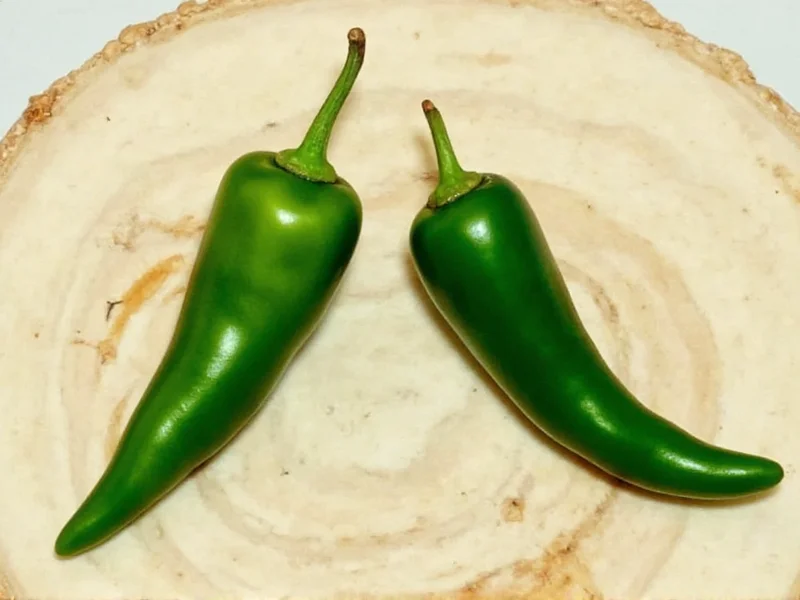The Scoville scale, developed by pharmacist Wilbur Scoville in 1912, measures the pungency or 'heat' of chili peppers and other spicy foods. Understanding where jalapeños fall on this scale helps home cooks, chefs, and spice enthusiasts make informed decisions about their culinary creations.
What the Jalapeño Scoville Range Means in Practice
That 2,500-8,000 SHU range might seem broad, but it reflects genuine variation in jalapeño heat levels. Several factors contribute to this variability:
- Ripeness: Green jalapeños (less ripe) tend to be milder, while red jalapeños (fully ripe) often pack more heat
- Growing conditions: Soil composition, climate, and water stress significantly impact capsaicin production
- Individual pepper variation: Even on the same plant, heat levels can differ substantially
- Part of the pepper: The placenta (white ribs) and seeds contain most capsaicin, while the flesh is milder
| Pepper Variety | Scoville Heat Units | Heat Level |
|---|---|---|
| Bell Pepper | 0 SHU | Mild |
| Jalapeño | 2,500-8,000 SHU | Medium |
| Serrano | 10,000-23,000 SHU | Hot |
| Habanero | 100,000-350,000 SHU | Very Hot |
| Ghost Pepper | 855,000-1,041,427 SHU | Extreme |
How Jalapeños Compare to Other Common Peppers
Understanding jalapeño scoville units becomes more meaningful when viewed in context. While jalapeños sit firmly in the medium heat category, they're significantly hotter than bell peppers (0 SHU) but milder than serranos (10,000-23,000 SHU). For reference, a typical jalapeño is about 14-28 times milder than a habanero.
This moderate heat level makes jalapeños versatile for cooking. They provide noticeable spice without overwhelming other flavors—ideal for salsas, nachos, poppers, and as a garnish. Most people can consume one or two jalapeños without significant discomfort, though sensitivity varies widely among individuals.
Practical Implications for Cooking and Consumption
When working with jalapeños, understanding their scoville heat range helps you manage spice levels in your dishes. Here's what the 2,500-8,000 SHU measurement means practically:
- For sensitive palates: Removing seeds and white ribs can reduce heat by up to 80%, bringing even hotter jalapeños to bell pepper territory
- For consistent results: Taste a small piece before adding to recipes, as heat can vary dramatically between peppers
- For preserving heat: Drying jalapeños concentrates capsaicin, increasing their effective heat level
- For pairing flavors: The moderate heat of jalapeños complements dairy (sour cream, cheese), sweet elements (mango, pineapple), and acidic components (lime juice)
Why Scoville Measurements Vary
The original Scoville Organoleptic Test involved diluting pepper extract until tasters could no longer detect heat. Modern methods use High-Performance Liquid Chromatography (HPLC) for precise capsaicin measurement, then convert to Scoville units. This scientific approach explains why contemporary measurements show more consistency than historical data.
Despite technological advances, natural variation remains. A jalapeño grown in New Mexico's arid climate might measure 7,000 SHU, while the same variety grown in humid Florida might register only 3,000 SHU. This natural variability is why understanding the range matters more than fixating on a single number when working with fresh peppers.
Using Jalapeños Effectively in Your Kitchen
Knowing the scoville heat units of jalapeños empowers you to use them strategically. For family-friendly dishes, select smoother, darker green jalapeños (typically milder) and remove all seeds and ribs. For authentic Mexican cuisine that honors traditional heat levels, use riper, slightly reddish jalapeños with some seeds intact.
When substituting jalapeños in recipes, remember that serranos provide similar flavor with increased heat (about 2-3 times hotter), while poblanos offer comparable flavor at significantly lower heat (1,000-2,000 SHU). This knowledge of scoville scale measurements transforms your ability to control and predict spice outcomes in cooking.
Can jalapeños be hotter than 8,000 Scoville units?
While the standard range is 2,500-8,000 SHU, exceptional jalapeños under extreme growing conditions have occasionally measured up to 10,000 SHU. However, peppers consistently exceeding 8,000 SHU are likely a different variety or a particularly hot jalapeño mutation.
Why do some jalapeños have black stripes?
Black stripes (corking) on jalapeños indicate stress during growth, often from intense sunlight or temperature fluctuations. Contrary to popular belief, corked jalapeños aren't necessarily hotter, though they may have more concentrated flavor.
How does cooking affect jalapeño heat?
Cooking can slightly reduce perceived heat as capsaicin dissolves into oils and liquids. However, the total capsaicin content remains unchanged. Roasting brings out sweetness that balances heat, while pickling preserves the original heat level.
Are red jalapeños hotter than green ones?
Generally yes. As jalapeños ripen from green to red, they develop more capsaicin, increasing their heat. Red jalapeños also contain more sugar, creating a complex sweet-heat profile compared to the brighter, grassier green varieties.
What's the best way to handle jalapeños safely?
Always wear gloves when handling hot peppers and avoid touching your face. Wash hands thoroughly with soap afterward. If you experience burning, dairy products (milk, yogurt) neutralize capsaicin better than water. Never rub eyes after handling peppers without washing hands first.











 浙公网安备
33010002000092号
浙公网安备
33010002000092号 浙B2-20120091-4
浙B2-20120091-4